
Marion Hugh "Suge" Knight Jr. is an American music executive and the co-founder and former CEO of Death Row Records, who was a central figure in gangsta rap's commercial success. This feat is attributed to the record label's first two album releases: Dr. Dre's The Chronic in 1992 and Snoop Dogg's Doggystyle in 1993.

Death Row Records is an American record label that was founded in 1991 by The D.O.C., Dr. Dre, Suge Knight, and Dick Griffey. The label became a sensation by releasing multi-platinum hip-hop albums by West Coast-based artists such as Dr. Dre, Snoop Dogg (Doggystyle), Tha Dogg Pound, and Tupac during the 1990s. At its peak, Death Row was making over US$100 million a year.

Michel'le Denise Toussant, also spelled Toussaint, is an American R&B singer known for her songs from 1989 to the early 1990s. Her highest charting song is the top ten US Hot 100 hit "No More Lies". Between 2013 and 2015, Michel'le was one of six members on the TV One reality show R&B Divas: Los Angeles. She is also the subject of the 2016 biopic Surviving Compton: Dre, Suge & Michel'le.
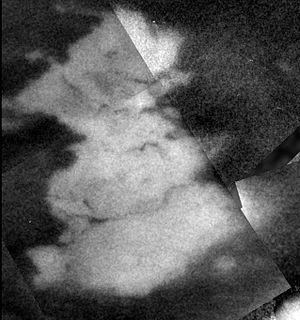
Shikoku Facula is a region of bright material on Saturn's moon Titan.
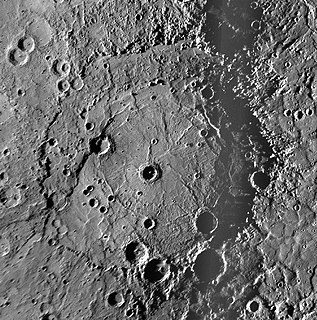
Rembrandt is a large impact crater on Mercury. With a diameter of 716 km it is the second-largest impact basin on the planet, after Caloris, and is one of the larger craters in the Solar System. It was discovered by MESSENGER during its second flyby of Mercury on October 6, 2008. The crater is 3.9 billion years old, and was created during the period of Late Heavy Bombardment. The density and size distribution of impact craters along Rembrandt's rim indicate that it is one of the youngest impact basins on Mercury.

Praxiteles is a crater on Mercury. It is one of many peak-ring basins on Mercury.
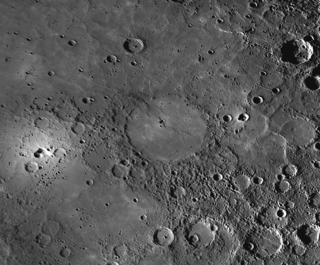
Copland is an impact crater on Mercury. Its floor is flooded with volcanic smooth plains material, which could be related to the activity that formed the nearby bright vent known as Nathair Facula.

Rachmaninoff is a peak-ring impact crater on Mercury. This basin, first imaged in its entirety during MESSENGER's third Mercury flyby, was quickly identified as a feature of high scientific interest, because of its fresh appearance, its distinctively colored interior plains, and the extensional troughs on its floor. The morphology of Rachmaninoff is similar to that of Raditladi, which is one of the youngest impact basins on Mercury. The age of Raditladi is estimated at one billion years. Rachmaninoff appears to be only slightly older.

A palimpsest, in planetary astronomy, is an ancient crater that has been degraded over time. They may also be referred to as "ghost craters", "degraded craters", "buried craters", or "pathological craters". Palimpsests have been identified on Mercury, the Earth, the Moon, Mars, Ganymede, Callisto, and possibly even Titan. On Mars, these features are morphologically described as craters that are "flat-floored, rimless, extremely shallow, without central peaks, and would probably represent what remains after erosion."

Hesiod is a crater on Mercury. It has a diameter of 101 kilometers. Its name was adopted by the International Astronomical Union (IAU) in 1976. Hesiod is named for the Ancient Greek poet Hesiod, who lived around 800 BCE.
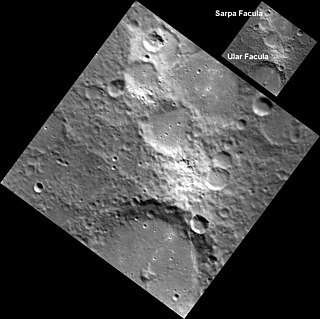
Ular Facula is a bright region on the surface of Mercury, located at 55.1° S, 29.95° W. It was named by the IAU in 2019. Ular is the Malay word for snake.

Sarpa Facula is a bright region on the surface of Mercury, located at 53.07° S, 30.87° W. It was named by the IAU in 2019. Sarpa is the Sinhalese word for snake.

Pampu Facula is a bright region on the surface of Mercury, located at 57.76° S, 31.79° W. It was named by the IAU in 2019. Pampu is the Tamil word for snake.
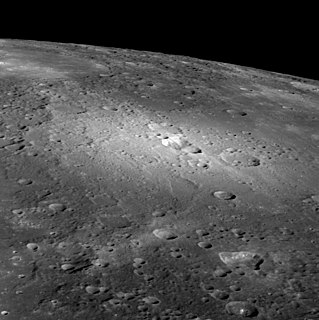
Nathair Facula is a bright region on the surface of Mercury, located at 36° N, 295.5° W. It was named by the IAU in 2018. Nathair is the Irish word for snake.

Neidr Facula is a bright, irregular depression on the surface of Mercury, located at 35.9° N, 302.7° W. It was named by the IAU in 2018. Neidr is the Welsh word for snake.

Donelaitis is a crater on Mercury. Its name was adopted by the International Astronomical Union (IAU) on May 15, 2013. Donelaitis is named for the Lithuanian poet Kristijonas Donelaitis.

Amaru Facula is a bright, irregular depression on the surface of Mercury, located at 49.8° S, 349.5° W. It was named by the IAU in 2018. Amaru is the Quechua word for snake.

Nākahi Facula is a bright, irregular depression on the surface of Mercury, located at 52.7° S, 342.2° W. It was named by the IAU in 2018. Nākahi is the Māori word for snake.
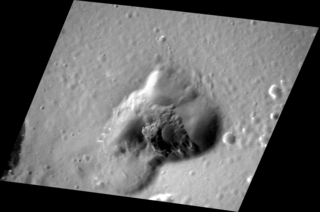
Agwo Facula is a bright, irregular depression on the surface of Mercury, located at 22.4° N, 213.7° W. It was named by the IAU in 2018. Agwo is the Igbo word for snake. The depression is the site of a volcanic explosion.
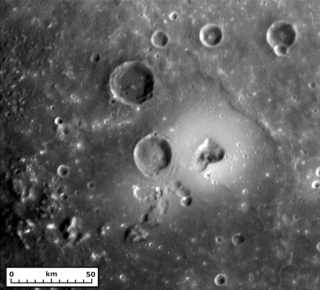
Abeeso Facula is a bright, irregular depression on the surface of Mercury, located at 21.7° N, 214.6° W. It was named by the IAU in 2018. Abeeso is the Somali word for snake. The depression is the site of a volcanic explosion.




















